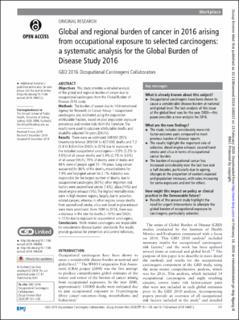| dc.contributor.author | Kisa, Adnan | |
| dc.contributor.author | Occupational Carcin. Collabora, GBD 2016 | |
| dc.date.accessioned | 2022-10-21T06:57:37Z | |
| dc.date.available | 2022-10-21T06:57:37Z | |
| dc.date.created | 2020-02-16T15:45:35Z | |
| dc.date.issued | 2020 | |
| dc.identifier.citation | Occupational and Environmental Medicine. 2020, 77, 151-159. | en_US |
| dc.identifier.issn | 1351-0711 | |
| dc.identifier.uri | https://hdl.handle.net/11250/3027449 | |
| dc.description.abstract | Objectives This study provides a detailed analysis of the global and regional burden of cancer due to occupational carcinogens from the Global Burden of Disease 2016 study.
Methods The burden of cancer due to 14 International Agency for Research on Cancer Group 1 occupational carcinogens was estimated using the population attributable fraction, based on past population exposure prevalence and relative risks from the literature. The results were used to calculate attributable deaths and disability-adjusted life years (DALYs).
Results There were an estimated 349 000 (95% Uncertainty Interval 269 000 to 427 000) deaths and 7.2 (5.8 to 8.6) million DALYs in 2016 due to exposure to the included occupational carcinogens—3.9% (3.2% to 4.6%) of all cancer deaths and 3.4% (2.7% to 4.0%) of all cancer DALYs; 79% of deaths were of males and 88% were of people aged 55 –79 years. Lung cancer accounted for 86% of the deaths, mesothelioma for 7.9% and laryngeal cancer for 2.1%. Asbestos was responsible for the largest number of deaths due to occupational carcinogens (63%); other important risk factors were secondhand smoke (14%), silica (14%) and diesel engine exhaust (5%). The highest mortality rates were in high-income regions, largely due to asbestos-related cancers, whereas in other regions cancer deaths from secondhand smoke, silica and diesel engine exhaust were more prominent. From 1990 to 2016, there was a decrease in the rate for deaths (−10%) and DALYs (−15%) due to exposure to occupational carcinogens.
Conclusions Work-related carcinogens are responsible for considerable disease burden worldwide. The results provide guidance for prevention and control initiatives. | en_US |
| dc.description.sponsorship | BPAQ acknowledges the Institutional support of PRONABEC (National Program of Scholarship and Educational Loan), provided by the Peruvian Government; and La Trobe University. ABad acknowledges support from the Public Health Agency of Canada. FC acknowledges UID/MULTI/04378/2019 support with funding from FCT/MCTES through national funds. EF acknowledges UID/QUI/50006/2019 support with funding from FCT/MCTES through national funds. MJak acknowledges that the Serbian part of this GBD contribution was cofinanced through Grant OI 175 014 of the Ministry of Education Science and Technological Development of the Republic of Serbia. YJK was supported by the Office of Research & Innovation, Xiamen University Malaysia. WM is currently a Program Analyst for Population and Development at the Peru Country Office of the United Nations Population Fund-UNFPA, an institution which does not necessarily endorse this study. AMS received a fellowship from the Egyptian Fulbright Mission Program (EFMP). RSar acknowledges institutional support from Applied and Environmental Sciences University, Bogota, Colombia and Carlos III Institute of Health. SMSI is funded by a Senior Research Fellowship from the Institute for Physical Activity and Nutrition (IPAN), Deakin University. RT-S was supported in part by grant number PROMETEOII/2015/021 from Generalitat Valenciana and the national grant PI17/00719 from ISCIII-FEDER | en_US |
| dc.language.iso | eng | en_US |
| dc.rights | Navngivelse 4.0 Internasjonal | * |
| dc.rights.uri | http://creativecommons.org/licenses/by/4.0/deed.no | * |
| dc.title | Global and regional burden of cancer in 2016 arising from occupational exposure to selected carcinogens: a systematic analysis for the Global Burden of Disease Study 2016 | en_US |
| dc.type | Peer reviewed | en_US |
| dc.type | Journal article | en_US |
| dc.description.version | publishedVersion | en_US |
| dc.source.pagenumber | 151-159. | en_US |
| dc.source.volume | 77 | en_US |
| dc.source.journal | Occupational and Environmental Medicine | en_US |
| dc.identifier.doi | 10.1136/oemed-2019-106012 | |
| dc.identifier.cristin | 1794481 | |
| cristin.unitcode | 1615,40,10,0 | |
| cristin.unitname | Institutt for helsevitenskap | |
| cristin.ispublished | true | |
| cristin.fulltext | original | |
| cristin.qualitycode | 2 | |

